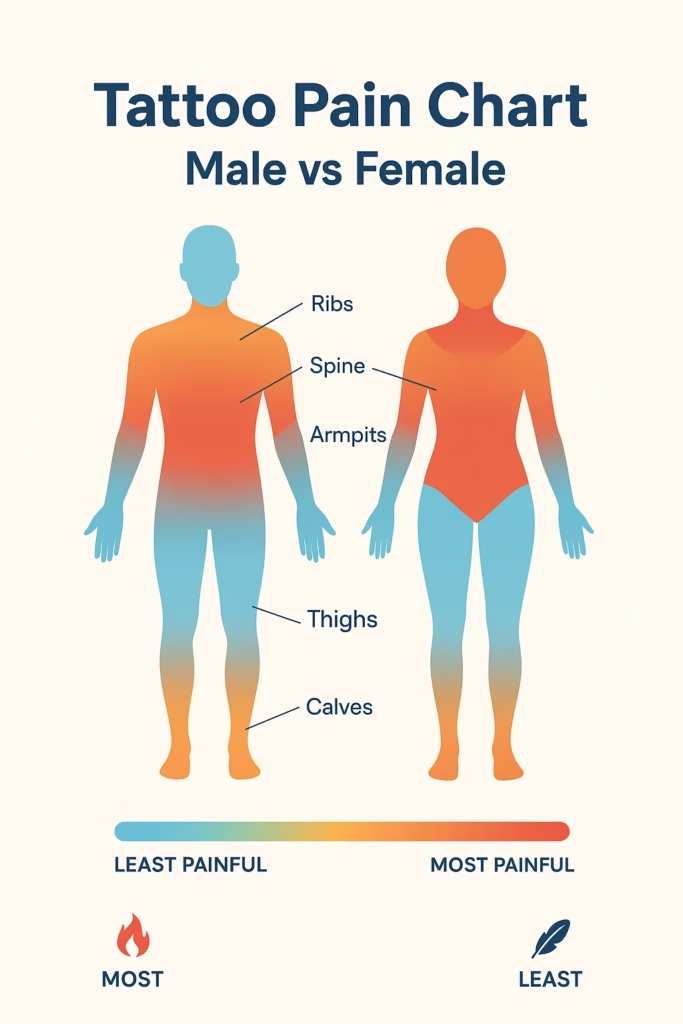Introduction
Getting a tattoo is an unforgettable experience, blending creativity, culture, and personal expression. But before that needle touches your skin, the most common question is: “How painful will it be?”
The truth: tattoos hurt. But the level of pain depends on where you get tattooed, your gender, your pain tolerance, and even the skill of the tattoo artist.
Understanding Tattoo Pain
When a tattoo machine punctures the skin, tiny needles deposit ink into the dermis. Each poke triggers pain signals to your brain. But how intense that pain feels depends on:
- Nerve endings – More nerves = sharper pain.
- Skin thickness – Thin skin feels more sensitive.
- Bone proximity – Tattoos over bone (like ribs, spine, or elbows) cause stinging pain.
- Pain tolerance – Some people simply handle pain better.
Tattoo Pain Chart
This chart helps both beginners and tattoo veterans understand what to expect depending on placement.
Most Painful Tattoo Placements
If you’re planning your first tattoo, you may want to avoid these spots. According to artists and research, these areas top the pain scale:
- Ribs – Sharp, stabbing pain with every breath.
- Spine – Highly sensitive nerve pathways.
- Armpits – Extremely tender and rarely recommended for beginners.
- Groin Area – Packed with nerves = severe discomfort.
- Elbows & Knees – Bone + thin skin = double the pain.
- Head, Face, and Neck – Vibrations and sensitivity make them very painful.
Least Painful Tattoo Placements
Want to ease into your tattoo journey? Start with these body parts that hurt less:
- Outer Shoulders – Muscular and padded.
- Upper Arms – A common first tattoo spot.
- Thighs (front) – Thick skin, more fat, tolerable.
- Calves – Great for medium to large designs.
- Forearms – Low pain and easy healing.
Tattoo Pain Chart Women vs Men
Many people search specifically for tattoo pain chart women or tattoo pain chart men, and for good reason—gender can influence pain perception.
Tattoo Pain Chart Female
- Women often report more sensitivity in areas like the hips, ribs, inner thighs, and chest, partly due to hormonal and nerve distribution differences.
- Menstrual cycle phases can also influence how pain is perceived.
Tattoo Pain Chart Male
- Men tend to have more muscle mass in areas like arms, chest, and legs, which can reduce tattoo pain slightly.
- However, areas with thin skin or bone (spine, elbows, knees) hurt just as much for men.
💡 Important: Studies show women generally have a lower pain threshold than men, but this varies individually. People generally find the ribs, armpits, and groin to be among the most painful areas for tattoos.
Factors That Influence Tattoo Pain
- Tattoo Size & Style – Large, detailed tattoos take longer, increasing discomfort.
- Shading vs. Outlining – Shading can hurt more because it covers wider areas repeatedly.
- Tattoo Artist’s Skill – Experienced artists minimize trauma to the skin.
- Your Health & Mood – Tired, stressed, or dehydrated? Expect more pain.
- Placement on the Body – As shown in the tattoo pain chart, placement is the biggest factor.
Age & Tattoo Pain
Does age matter when it comes to tattoo pain? Yes.
- Younger People – Often tolerate pain better due to skin elasticity.
- Older People – Thinner, looser skin may feel tattoos more sharply. Healing can also be slower.
Tips to Reduce Tattoo Pain
- Sleep well the night before.
- Eat a filling meal—low blood sugar increases pain.
- Stay hydrated—healthy skin takes ink better.
- Avoid alcohol & caffeine—they thin your blood.
- Use numbing creams (only if approved by your tattoo artist).
- Take breaks during long sessions.
- Breathe & relax—tensing up makes it worse.
Tattoo Healing & Aftercare
The pain doesn’t stop when the tattoo is done—healing can also be uncomfortable. Follow these steps:
- Wash gently with fragrance-free soap.
- Apply tattoo aftercare ointment.
- Avoid scratching or picking scabs.
- Stay out of the sun and pools.
- Wear loose clothing over the area.
Proper aftercare reduces pain, prevents infection, and keeps your tattoo looking vibrant.
For more lifestyle and health insights, visit Blog Adviser 365.
FAQs About Tattoo Pain
1. Do tattoos hurt more on fat or muscle?
Generally, tattoos hurt less on muscle and fatty areas compared to bony spots.
2. Do smaller tattoos hurt less?
Yes, smaller tattoos are quicker, but pain still depends on placement.
3. Can I take painkillers before my tattoo?
Avoid aspirin or ibuprofen—they thin the blood. Ask your artist before taking anything.
4. Do tattoos hurt more for men or women?
Women are slightly more sensitive in certain areas, but placement is the key factor.
5. Which is the least painful first tattoo spot?
Forearm, calf, or outer shoulder.
Conclusion
Tattoos will always involve some pain, but the tattoo pain chart helps you prepare by showing which body parts hurt most and least.
- Least painful: outer shoulders, calves, forearms.
- Most painful: ribs, spine, groin, armpits.
If you’re new, choose a less painful area and gradually work toward more sensitive placements. With proper preparation and aftercare, the tattoo experience becomes far more enjoyable.
Learn more from trusted resources like Healthline’s Tattoo Pain Guide.








